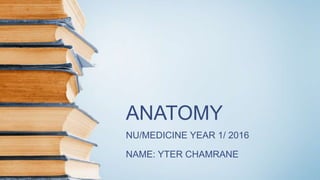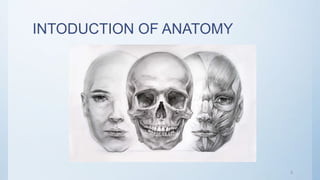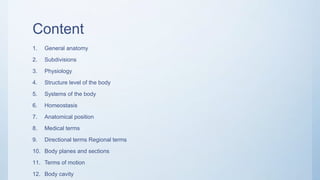Introduction of human body
- 1. ANATOMY NU/MEDICINE YEAR 1/ 2016 NAME: YTER CHAMRANE
- 3. objective ? After this slide you may know some basic of anatomy . ? You will be able to describe and understand the what is anatomy?
- 4. Content 1. General anatomy 2. Subdivisions 3. Physiology 4. Structure level of the body 5. Systems of the body 6. Homeostasis 7. Anatomical position 8. Medical terms 9. Directional terms Regional terms 10. Body planes and sections 11. Terms of motion 12. Body cavity
- 5. 1.Generality of anatomy ? The word ( anatomy) is derived from Greek root that mean °∞ to cut up°± or °∞to dissect°± or °∞to separate°±. ? To study of human anatomy in its early stage was adequately defined by this term for anatomy dealt only with structures that could be displayed by dissection and that were visible to the naked eye, what we now call °∞ gross anatomy°±.
- 6. What is anatomy? ? Anatomy include to the structures that can be seen grossly (without the aid of magnification) and microscopically (with the aid of magnification).
- 7. 2.Subdivisions ? Anatomy divide into 4 spheres: ? Gross anatomy (by eye) ? Neuro anatomy (brain + Spine) ? Microscopic anatomy ( histology) ? Development anatomy or embryology
- 8. Macroscopic (gross) Anatomy ? Studies of the body parts and their relationship. ( e.g : heart, lung, kidney..etc) ? Can be further divided into: 1. Regional Anatomy - all structures in one particular region. 8
- 9. Macroscopic (gross) Anatomy 2. Systemic Anatomy - system by system 3. Surface Anatomy -study of external body structures 9
- 10. Microscopic Anatomy ? Very small structures that cannot be seen with naked eyes. 1. cytology: - study of body cell 2. Histology: - study of body tissues 10
- 11. Developmental Anatomy ? Structural changes to the body throughout lifespan. 1. Embryology - Development which occur before birth 11
- 12. NeuroAnatomy ? The study of the anatomy and serotyped organization of nervous system. 12
- 13. 3.Physiology ? Study of the body function. 1. System Physiology - study of body system°Øs function. 2. Comparative Physiology - study of various characteristic of living organisms. 3. Medical physiology - Study of physiological dysfunction and diseases. 13
- 14. 4.Structural level of the body 14
- 15. 5.System of the body ? Integumentary system - external cover of the body(Skin) - protects deeper tissue from injury - Site of cutaneous, receptors, sweet and oil glands. 15
- 16. System of the body ? Skeletal System - bones - Protects and supports body organs 16
- 17. System of the body ? Muscular System - Muscles - produce body movement 17
- 18. System of the body ? Nervous System - Consist of brain, sensory receptor, nerves, spinal cord. - Control homeostasis by stimulating particular muscles contraction and gland secretion. 18
- 19. System of the body ? Endocrine System - Hormones secretion to Regulate body processes. 19
- 20. System of the body ? Cardiovascular System - transport blood to the body. 20
- 21. System of the body ? Lymphatic / Immune System - Protect the body by attacking from foreign substances entering body system. 21
- 22. System of the body ? Respiratory System - Supply blood with oxygen and removing carbon dioxide. 22
- 23. System of the body ? Digestive System - Break down the food for absorption - Indigestible food will be removed as faces 23
- 24. System of the body ? Urinary System - Regulation of water, electrolytes and acid-base balance in the body. 24
- 25. System of the body ? Reproductive System - Production of babies 25
- 26. 6.Homeostasis ? Body°Øs ability to maintain relativity stable internal conditions although the external environment keep changing.. ? 3 components: 26
- 27. Homeostasis ? Negative Feedback Mechanism -Restoring back the body to its original state. -Cut-off the original stimulus and reduce the intensity -Make up most of the homeostasis control mechanism -Avoid sudden and harmful changes to our body Eg: Insulin will be secreted if the glucose level in blood is too high. 27
- 28. 28
- 29. Homeostasis ? Positive Feedback Mechanism -Triggering an enhance action from the original stimulus. - Commonly for the activity that do not need further adjustment. Eg: Blood clotting where platelets will pile up and clot at the injured side. 29
- 30. 30
- 31. 7.Anatomical Position ? Standing position with the body erect facing forward, feet slightly apart, arms hanging and palms also facing forward. 31
- 34. 10.Regional terms ? Axial Region -Axis of our body - Comprise of three parts: head, neck and trunk ? Perpendicular Region -limbs, or appendages -body parts that attached to the axis. 34
- 35. 11.Body Planes And Sections ? Sagittal Plane - Vertical plane divide body into right and left - Sagittal plane that exactly cut in the middle called midsagittal plane or median plane. - Sagittal plane that offset from median line called Parasagittal plane. 35
- 36. Body Planes And Sections ? Frontal Plane( coronal plane) - vertical line that divide the body to anterior and posterior parts. 36
- 37. Body Planes And Sections ? Transverse Plane( Horizontal Plane ) - Horizontal plane which divide body into Superior and inferior. 37
- 38. Body Planes And Section 38
- 39. Body Planes And Section 39
- 40. Body Planes And Section 40
- 43. 13.Body cavities 43 ? Dorsal Cavity: protects nervous system ? Two subdivisions: 1. Cranial cavity ®C brain 2. Spinal cavity ®C spinal cord ? Ventral Cavity: house visceral organs ? Two subdivisions: 1. Thoracic cavity ®C pleura(lung), mediastinum (heart, esophagus, trachea, etc°≠) 2. Abdominal cavity ®C abdominal (liver, stomach..) and pelvic(bladder, reproductive system, rectum).
- 44. Body cavities 44
- 45. 45













































